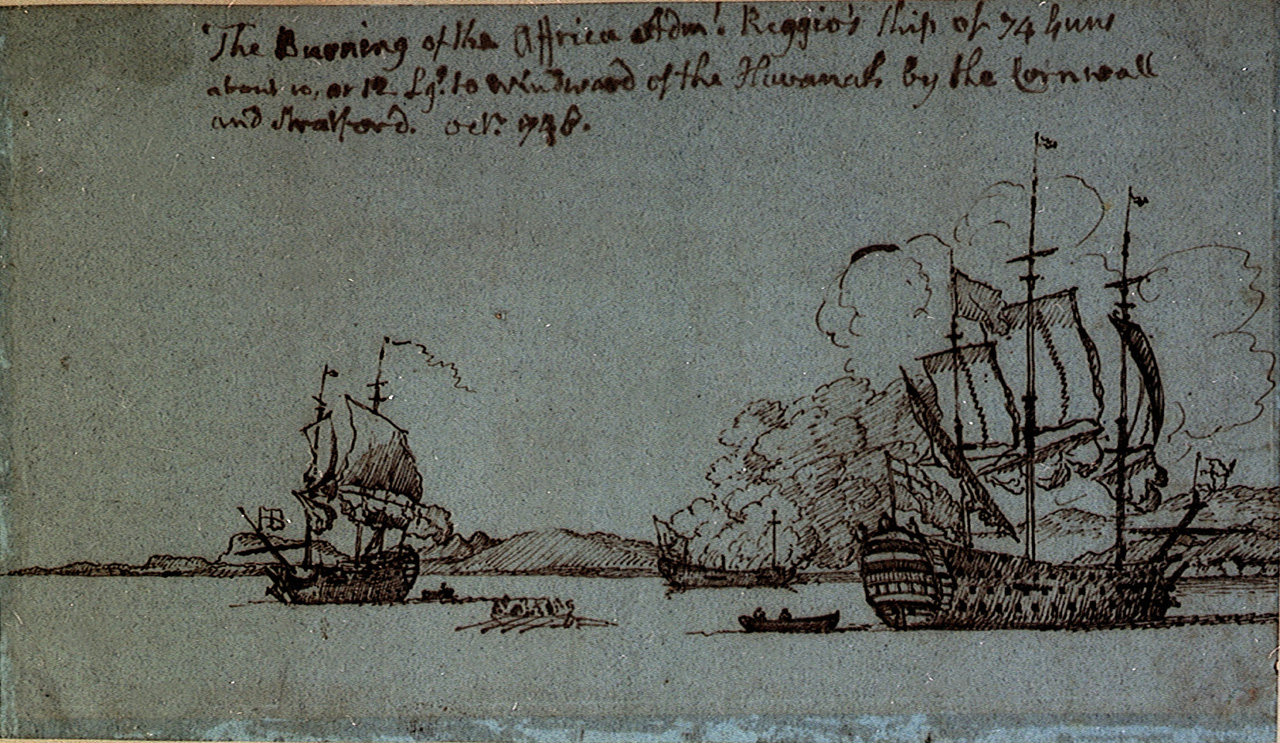HMS Strafford (1735) on:
[Wikipedia]
[Google]
[Amazon]
HMS ''Strafford'' was a 60-gun
 She was at the Battle of Havana in 1748.
''Strafford'' served until 1756, when she was sunk as part of a breakwater.
She was at the Battle of Havana in 1748.
''Strafford'' served until 1756, when she was sunk as part of a breakwater.
fourth rate
In 1603 all English warships with a compliment of fewer than 160 men were known as 'small ships'. In 1625/26 to establish pay rates for officers a six tier naval ship rating system was introduced.Winfield 2009 These small ships were divided i ...
ship of the line
A ship of the line was a type of naval warship constructed during the Age of Sail from the 17th century to the mid-19th century. The ship of the line was designed for the naval tactic known as the line of battle, which depended on the two colu ...
of the Royal Navy
The Royal Navy (RN) is the United Kingdom's naval warfare force. Although warships were used by English and Scottish kings from the early medieval period, the first major maritime engagements were fought in the Hundred Years' War against F ...
, built to the 1733 proposals of the 1719 Establishment
The 1719 Establishment was a set of mandatory requirements governing the construction of all Royal Navy warships capable of carrying more than 20 naval long guns. It was designed to bring economies of scale through uniform vessel design, and ens ...
of dimensions at Chatham Dockyard
Chatham Dockyard was a Royal Navy Dockyard located on the River Medway in Kent. Established in Chatham in the mid-16th century, the dockyard subsequently expanded into neighbouring Gillingham (at its most extensive, in the early 20th century, ...
, and was launched on 24 July 1735.
Engagements
HMS ''Strafford'' took part in the destruction of the fortress of San Lorenzo el Real Chagres (22-24 March 1740), inPanama
Panama ( , ; es, link=no, Panamá ), officially the Republic of Panama ( es, República de Panamá), is a transcontinental country spanning the southern part of North America and the northern part of South America. It is bordered by Cos ...
, as part of a squadron commanded by Vice-Admiral Edward Vernon
Admiral Edward Vernon (12 November 1684 – 30 October 1757) was an English naval officer. He had a long and distinguished career, rising to the rank of admiral after 46 years service. As a vice admiral during the War of Jenkins' Ear, in 1 ...
during the War of Jenkins' Ear
The War of Jenkins' Ear, or , was a conflict lasting from 1739 to 1748 between Britain and the Spanish Empire. The majority of the fighting took place in New Granada and the Caribbean Sea, with major operations largely ended by 1742. It is con ...
.
At 3 pm on 22 March 1740, the English squadron
Squadron may refer to:
* Squadron (army), a military unit of cavalry, tanks, or equivalent subdivided into troops or tank companies
* Squadron (aviation), a military unit that consists of three or four flights with a total of 12 to 24 aircraft, de ...
, composed of the ships ''Strafford'', ''Norwich'', ''Falmouth'' and ''Princess Louisa'', the frigate , the bomb vessel
A bomb vessel, bomb ship, bomb ketch, or simply bomb was a type of wooden sailing naval ship. Its primary armament was not cannons ( long guns or carronades) – although bomb vessels carried a few cannons for self-defence – but mortars mounte ...
s , and , the fireship
A fire ship or fireship, used in the days of wooden rowed or sailing ships, was a ship filled with combustibles, or gunpowder deliberately set on fire and steered (or, when possible, allowed to drift) into an enemy fleet, in order to destroy sh ...
s and , and transports ''Goodly'' and ''Pompey'', under Vernon's command, began to bombard the Spanish fortress. Given the overwhelming superiority of the English forces, Captain Don Juan Carlos Gutiérrez Cevallos surrendered the fort on 24 March, after resisting for two days.
 She was at the Battle of Havana in 1748.
''Strafford'' served until 1756, when she was sunk as part of a breakwater.
She was at the Battle of Havana in 1748.
''Strafford'' served until 1756, when she was sunk as part of a breakwater.
Notes
References
*Lavery, Brian (2003) ''The Ship of the Line - Volume 1: The development of the battlefleet 1650-1850.'' Conway Maritime Press. .External links
* Ships of the line of the Royal Navy 1730s ships {{UK-line-ship-stub